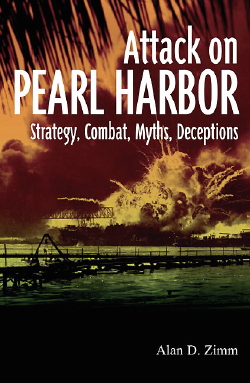 Attack on Pearl Harbor
Attack on Pearl Harbor
Strategy, Combat, Myths, Deceptions
By Alan D. Zimm. 464 pp.
Casemate Publishers, 2011. $32.95.
For seven decades, conventional wisdom has extolled the Japanese attack on Pearl Harbor as brilliant in its planning and execution. Alan D. Zimm’s masterful analysis topples that pillar of Pacific War history. Zimm, the author of last issue’s “The Pearl Harbor Myth,” distills his exacting scrutiny of Japanese planning and execution into a list of 18 major points. They comprise a damning indictment of the Imperial Japanese Navy for faulty planning choices and egregious execution errors that lessened the attack’s success.
Zimm condemns Japan’s planning for, above all, its inflexibility. Doubts about whether they could devise torpedoes that would work in Pearl Harbor’s shallow waters, along with the possibility that the Americans might use torpedo nets, prompted an early decision to limit the number of torpedo-carrying Nakajima B5Ns (“Kates”) to 40, while allocating 50 Kates to wield converted 16.1-inch (410mm) shells as armor-piercing bombs. Because there was no cross-training between these two groups, there was no margin to reassign more Kates to torpedo bombing even after the proper torpedoes were perfected—a move that might have significantly increased their margin of victory. Zimm correctly emphasizes that the lack of effective aircraft radios imposed a serious handicap on Japanese command and control, reducing air leaders to using the crudest “follow me” command techniques. And Zimm demonstrates that the fumbled signal to initiate the attack had numerous baleful consequences for the Japanese.
Zimm gives the attack’s execution mixed grades. The Japanese destroyed far more planes on the ground than historical norms predicted, but that was largely because Lieutenant General Walter Short, the army commander responsible for the defense of Hawaii’s military installations, had neatly grouped his planes for slaughter. The Kate level bombers exceeded expectations, but defective bombs undermined their achievement, with the horrifying exception of the Arizona. Zimm also severely judges the effectiveness of the Zeros in both strikes and the 78 dive-bombers in the second wave of the attack.
Perhaps Zimm’s most striking point concerns the Japanese goal of sinking or disabling four battleships. Surprisingly, he shows that Admiral Isoroku Yamamoto—the attack’s chief planner who realistically assessed Japan’s slim chances in a prolonged fight with the United States—targeted battleships because his real audience for the attack was the American people. Yamamoto hoped the loss of these supreme emblems of sea power would demoralize the American public, and, coupled with Japan’s initial surge across Asia and the Pacific, lead to a swift negotiated halt to the war.
On the other side of the attack, Zimm highlights devastating but avoidable flaws in Hawaii’s defenses. The Japanese provided three warnings of their presence: midget subs attempting to penetrate the harbor before the attack, and two radar tip-offs—first from two advanced scout planes, and then from the first mass wave. The radar warnings were squandered for lack of an operational air information center, the fault of both General Short and Admiral Husband Kimmel, the commander in chief of the U.S. Pacific Fleet. Zimm makes a strong case that heeding these alarms could have sharply reduced the attack’s effectiveness, and perhaps could have even turned it into a Japanese fiasco.
Attack on Pearl Harbor has tremendous merits, but also a few drawbacks. By limiting its scrutiny so narrowly to the events of that fateful Sunday morning, it inadvertently obscures two central facts: the Imperial Navy achieved a colossal triumph by projecting a task force to Hawaii undetected, and then initiated an entirely new form of naval warfare with a huge strike from massed aircraft carriers. Combat veterans may look askance at Zimm’s lack of allowance for the inevitable “friction” between ideal performance and what actually happens when the bullets are flying. Nevertheless, with its amazing depth of meticulous research and analysis, this forceful book is essential reading for anyone with a serious interest in Pearl Harbor.




